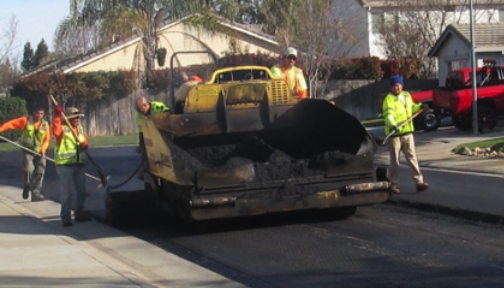Reimagine Your Room: Hot Mix Asphalt Paving for Angled Parking Lot Tasks
Reimagine Your Room: Hot Mix Asphalt Paving for Angled Parking Lot Tasks
Blog Article
Opening the Secrets of Warm Mix Asphalt Modern Technology
Exploring the midsts of warm mix asphalt innovation uncovers a globe where meticulous procedures and accurate formulations merge to shape our roadways and facilities. The fusion of fillers, aggregates, and binders isn't simply a construction job however a strategic orchestration of resilience and performance.
Value of Hot Mix Asphalt
Warm Mix Asphalt plays an important duty in contemporary framework advancement as a result of its sturdiness and cost-effectiveness. As the most commonly utilized leading material for roads, freeways, and vehicle parking whole lots, Hot Mix Asphalt supplies a variety of advantages that add to its value in construction jobs. One vital advantage is its capability to withstand rush hour tons and extreme weather conditions, supplying a dependable and resilient surface area for transport networks. Furthermore, Warm Mix Asphalt is cost-efficient in both initial building and lasting upkeep, making it a recommended selection for many facilities jobs.
The longevity of Warm Mix Asphalt stems from its composition, which consists of accumulations, binder, and filler materials that are carefully picked and mixed to meet details performance needs. Generally, the significance of Warm Mix Asphalt in framework advancement can not be understated, as it proceeds to be a cornerstone of contemporary construction methods.
Components of Asphalt Mixes
The make-up of asphalt mixes contains meticulously selected accumulations, binder, and filler products that are essential for achieving certain performance demands. Accumulations are the key component of asphalt blends, providing stamina and stability. These aggregates can be all-natural, such as gravel or crushed rock, or artificial, like recycled materials from old pavements. The binder, typically bitumen or asphalt concrete, holds the aggregates together and supplies flexibility and resilience to the mix. The option of the binder is crucial as it directly affects the mix's efficiency in different weather. Fillers, such as moisturized lime or Portland concrete, are made use of to enhance the mix's workability and aging resistance. Angled Parking.
The combination and proportion of these parts play a substantial function in establishing the quality and performance of the asphalt mix. Designers carefully design the mix to meet particular requirements, considering elements like website traffic quantity, environment problems, and pavement life expectancy. Proper selection and balancing of accumulations, binder, and fillers are vital for developing sturdy, long-lasting asphalt sidewalks.
Combining and Manufacturing Techniques

Once the aggregates are selected, the binder, typically asphalt concrete, is included in bind the materials together. The binder's quality and quantity considerably affect the mix's versatility, stamina, and resistance to environmental elements. Additionally, fillers like hydrated lime or Rose city concrete might be integrated to improve particular characteristics of the asphalt mix, such as its workability or moisture resistance.
Throughout manufacturing, the aggregates and binder are heated, commonly between 250-325 ° F(121-163 ° C ), to help with mixing and make certain correct finish of the aggregates. The mixing procedure needs to be extensive to achieve a homogeneous mixture that advertises the preferred performance features of the asphalt. Different techniques, such as set mixing or drum blending, are utilized to achieve premium and consistent asphalt blends for building projects.
Aspects Impacting Asphalt Efficiency
Aspects affecting asphalt performance include an array of variables that influence the longevity, durability, and general top quality of asphalt pavements. One essential aspect is the top quality of materials used in the asphalt mix.

Environmental problems also affect asphalt performance. Temperature variants, moisture seepage, and traffic tons can all impact the structural honesty of the pavement. Style factors to consider, such as pavement thickness and water drainage, are important in making certain the long-term efficiency of the asphalt sidewalk. By thoroughly taking into consideration these designers, elements and service providers can enhance asphalt efficiency and boost the life span of sidewalks.
Lasting Practices in Asphalt Innovation
:max_bytes(150000):strip_icc()/asphalt-worker-134249388-58cdf96f5f9b581d723f2f33.jpg)
WMA enables for the manufacturing and placement of asphalt blends at lower temperature levels compared to standard hot-mix asphalt, resulting in reduced power intake and greenhouse gas discharges. The usage of porous asphalt blends can aid reduce stormwater drainage concerns by enabling water to penetrate through the linked here pavement and right into the ground, advertising natural water filtering and reenergize processes.
Final Thought
Finally, hot mix asphalt innovation plays an important role in modern framework development as a result of its sturdiness and cost-effectiveness. By very carefully stabilizing parts, employing correct mixing methods, and taking into consideration numerous variables, designers can develop high-quality asphalt mixes that endure heavy traffic loads and severe weather. Accepting sustainable practices, such as using warm-mix modern technologies and recycled products, better boosts the ecological friendliness of asphalt technology.
Blending and manufacturing strategies in hot mix asphalt technology involve the specific mix and processing of aggregates, binder, and fillers to develop a sturdy and high-performance asphalt mix.Aspects influencing asphalt efficiency include a range of variables that impact the sturdiness, durability, and overall top quality of asphalt pavements. Sustainable techniques in asphalt innovation encompass different initiatives intended at useful source minimizing the environmental influence of asphalt production and paving procedures. By integrating reclaimed asphalt pavement (RAP) and recycled asphalt tiles (RAS) into brand-new asphalt mixes, the sector can substantially decrease the intake of raw products and power, while also lowering landfill waste.
WMA permits for the production and positioning of asphalt blends at lower temperature levels contrasted to standard hot-mix asphalt, resulting in reduced energy intake and greenhouse gas discharges.
Report this page